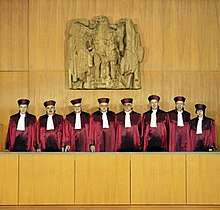Federal Constitutional Court
| Federal Constitutional Court | |
|---|---|
|
| |
| Established | 1951[1] |
| Country | Federal Republic of Germany |
| Location | Karlsruhe, Baden-Württemberg, Germany |
| Coordinates | 49°00′45″N 8°24′06″E / 49.012422°N 8.40161°ECoordinates: 49°00′45″N 8°24′06″E / 49.012422°N 8.40161°E |
| Composition method | Bundestag or Bundesrat appointment |
| Authorized by | Basic Law of Germany (Grundgesetz) |
| Judge term length | 12 years (mandatory retirement at 68) |
| No. of positions | 16, halved into two Senates |
| Website |
www |
| President of the Court | |
| Currently | Andreas Voßkuhle |
| Since | March 2010 |
 |
|---|
| This article is part of a series on the politics and government of Germany |
|
| Foreign relations |
|
|


The Federal Constitutional Court (German: Bundesverfassungsgericht; abbreviated: BVerfG) is the supreme constitutional court for the Federal Republic of Germany, established by the constitution or Basic Law (Grundgesetz) of Germany. Since its inception with the beginning of the post-WW2 republic, the court has been located in the city of Karlsruhe—intentionally distanced from the other federal institutions in Berlin (earlier in Bonn) and other cities.
The main task of the court is judicial review, and it may declare legislation unconstitutional, thus rendering them ineffective. In this respect, it is similar to other supreme courts with judicial review powers, yet the court possesses a number of additional powers, and is regarded as among the most interventionist and powerful national courts in the world. Unlike other supreme courts, the constitutional court is not an integral stage of the judicial or appeals process (aside from cases concerning constitutional or public international law), and does not serve as a regular appellate court from lower courts or the Federal Supreme Courts on any violation of federal laws.
The court's jurisdiction is focused on constitutional issues and the compliance of all governmental institutions with the constitution. Constitutional amendments or changes passed by the Parliament are subject to its judicial review, since they have to be compatible with the most basic principles of the Grundgesetz defined by the eternity clause.[note 1]
The court's practice of enormous constitutional control frequency on the one hand, and the continuity in judicial restraint and political revision on the other hand, have created a unique defender of the Grundgesetz since World War II and given it a significant role in Germany's modern democracy.

Scope
Article 20 Section 3 of the Basic Law stipulates that all three branches of the state (the legislature, executive, and judiciary) are bound directly by the constitution. As a result, the court can rule acts of any branches unconstitutional, whether as formal violations (exceeding powers or violating procedures) or as material conflicts (when the civil rights prescribed in the Grundgesetz are not respected).
The powers of the Federal Constitutional Court are defined in article 93 of the Grundgesetz.[2] This constitutional norm is set out in a federal law, the Federal Constitutional Court Act (BVerfGG), which also defines how decisions of the court on material conflicts are put into force. The Constitutional Court has therefore several strictly defined procedures in which cases may be brought before it:
- Constitutional complaint: By means of the Verfassungsbeschwerde (constitutional complaint) any person may allege that his or her constitutional rights have been violated. Although only a small fraction of these are actually successful (ranging around 2.5% since 1951), several have resulted in major legislation being invalidated, especially in the field of taxation. The large majority of the court's procedures fall into this category; 135,968 such complaints were filed from 1957 to 2002.
- Abstract regulation control: Several political institutions, including the governments of the Bundesländer (states), may bring a federal law before the court if they consider it unconstitutional. A well-known example of this procedure was the 1975 abortion decision, which invalidated legislation intended to decriminalise abortion.
- Specific regulation control: Any regular court which is convinced, that a law in question for a certain case is not in conformance with the constitution must suspend that case and bring this law before the Federal Constitutional Court.
- Federal dispute: Federal institutions, including members of the Bundestag, may bring internal disputes over competences and procedures before the court.
- State–federal dispute: The Länder may bring disputes over competences and procedures between the states and federal institutions before the court.
- Investigation committee control
- Federal election scrutiny: Violations of election laws may be brought before the court by political institution or any involved voter.
- Impeachment procedure: Impeachment proceedings may be brought against the Federal President, a judge, or a member of one of the Federal Supreme Courts, by the Bundestag, the Bundesrat or the federal government, based on violation of constitutional or federal law.
- Prohibition of a political party: Only the Constitutional Court has the power to ban a political party in Germany. This has happened just twice, both times in the 1950s: the Socialist Reich Party (SRP), a neo-Nazi group, was banned in 1952, and the Communist Party of Germany (KPD) was banned in 1956. A third such procedure to prohibit the far-right National Democratic Party of Germany (NPD) failed in 2003 after the court discovered that many of the party officials were in fact controlled by the German secret services that had injected its agents for the sake of surveillance. Three judges objected to continuing which was sufficient as banning a party requires a two-thirds-majority. The court did not decide on the ban itself.
Up to 2009, the Constitutional Court had struck down more than 600 laws as unconstitutional.[3]
Organization
The court consists of two senates, each of which has eight members, headed by a senate’s chairman. The members of each senate are allocated to three chambers for hearings in constitutional complaint and single regulation control cases. Each chamber consists of three judges, so each senate chairman is at the same time a member of two chambers.
Decisions by a senate require a majority. In some cases a two-thirds vote is required (§ 15 IV 1 BVerfGG). Decisions by a chamber need to be unanimous. A chamber is not authorized to overrule a standing precedent of the senate to which it belongs; such issues need to be submitted to the senate as a whole. Similarly, a senate may not overrule a standing precedent of the other senate, and such issues will be submitted to a plenary meeting of all 16 judges (the Plenum).
Unlike all other German courts, the court often publishes the vote count on its decisions (though only the final tally, not every judge's personal vote) and even allows its members to issue a dissenting opinion. This possibility, introduced only in 1971, is a remarkable deviation from German judicial tradition.
One of the two senate chairmen is also the President of the court, the other one being the Vice President. The presidency alternates between the two senates, i.e. the successor of a President is always chosen from the other senate. The 9th and current president of the court is Andreas Voßkuhle.
Democratic function
| “ | [the] court is an important institution for the protection of minority interests[4] | ” |
The Constitutional Court is able to actively administer the law and ensure that political and bureaucratic decisions comply with the rights of the individual enshrined in the Basic Law. Specifically, it can vet the democratic and constitutional legitimacy of bills proposed by federal or state government, scrutinise decisions (such as those relating to taxation) by the administration, arbitrate disputes over the implementation of law between states and the federal government, and (most controversially) ban non-democratic political parties.[5] The Constitutional Court enjoys more public trust than the federal or state parliaments, which some say derives from the German enthusiasm for the rule of law.[6]
Appointment of judges
The court's judges are elected by the Bundestag (the German parliament) and the Bundesrat (a legislative body that represents the sixteen state governments on the federal level). According to the Basic Law, each of these bodies selects four members of each senate, while the authority to select the court's president alternates between them. The selection of a judge requires a two-thirds vote.
Until 2015 the Bundestag has delegated this task to a special body (Richterwahlausschuss, judges election board), consisting of a small number of Bundestag members. This procedure has caused some constitutional concern and was considered to be unconstitutional by many scholars. In 2015 the Bundesverfassungsgerichtsgesetz (law code of the Federal Constitutional Court) was changed in this aspect, ruling that the Bundestag elects judges to the court by secret ballot in the plenum, requiring a candidate to get a two-thirds majority, that has to equal at least an absolute majority of members of the Bundestag. The Richterwahlausschuss now only has to nominate a candidate.[7] This new procedure was applied for the first time in September 2017, when Josef Christ was elected to the first senate as the successor of Wilhelm Schluckebier. In the Bundesrat, a chamber in which the governments of the sixteen German states are represented (each state has 3 to 6 votes depending on its population, which it has to cast en bloc), a candidate currently needs at least 46 of 69 possible votes.
The judges are elected for a 12-year term, but they must retire upon reaching the age of 68. A re-election is not possible. A judge must be at least 40 years old and must be a well-trained jurist. Three out of eight members of each senate have served as a judge on one of the federal courts. Of the other five members of each senate, most judges previously served as an academic jurist at a university, as a public servant or as a lawyer. After ending their term, most judges withdraw themselves from public life. However, there are some prominent exceptions, most notably Roman Herzog, who was elected President of Germany in 1994, shortly before the end of his term as president of the court.
Current members


| Name | Term | Nomination by | Election by |
|---|---|---|---|
| First Senate | |||
| Ferdinand Kirchhof (born 1950) (Vice-President of the Court, Chairman of the First Senate) |
October 2007 – June 2018 (retirement) | CDU/CSU | Bundestag |
| Josef Christ (born 1956) | November 2017 – November 2024 (retirement) | CDU/CSU | Bundestag |
| Michael Eichberger (born 1953) | April 2006 – April 2018 (12-year-term) | CDU/CSU | Bundesrat |
| Gabriele Britz (born 1968) | February 2011 – February 2023 (12-year term) | SPD | Bundesrat |
| Johannes Masing (born 1959) | April 2008 – April 2020 (12-year term) | SPD | Bundesrat |
| Susanne Baer (born 1964) | February 2011 – February 2023 (12-year term) | Alliance '90/The Greens | Bundestag |
| Yvonne Ott (born 1963) | November 2016 – November 2028 (12-year-term) | SPD | Bundesrat |
| Andreas L. Paulus (born 1968) | March 2010 – March 2022 (12-year term) | FDP | Bundestag |
| Second Senate | |||
| Andreas Voßkuhle (born 1963) (President of the Court, Chairman of the Second Senate) |
May 2008– May 2020 (12-year term) | SPD | Bundesrat |
| Peter M. Huber (born 1959) | October 2010 – October 2022 (12-year term) | CDU/CSU | Bundestag |
| Monika Hermanns (born 1959) | November 2010 – November 2022 (12-year term) | SPD | Bundestag |
| Sibylle Kessal-Wulf (born 1958) | December 2011 – December 2023 (12-year term) | CDU/CSU | Bundesrat |
| Peter Müller (born 1955) | December 2011 – December 2023 (12-year term) | CDU/CSU | Bundesrat |
| Doris König (born 1957) | June 2014 – June 2024 (12-year term) | SPD | Bundestag |
| Ulrich Maidowski (born 1958) | July 2014 – July 2026 (12-year term) | SPD | Bundestag |
| Christine Langenfeld (born 1962) | July 2016 – July 2028 (12-year term) | CDU/CSU | Bundesrat |
Presidents of the court
The court's head is the President of the Federal Constitutional Court, who chairs one of the two senates and joint sessions of the court, while the other senate is chaired by the Vice President of Federal Constitutional Court. The right to elect the President and the Vice President alternates between the Bundestag and the Bundesrat. If the President of the Federal Constitutional Court leaves office, i.e. when his or her term as judge at the court ends, the legislative body, whose turn it is to choose the President, has to elect one of the judges of the senate, of which the former President wasn't a member, with a two-thirds-majority. The same applies, if the office of Vice President falls vacant. The given legislative body is free to elect the judge it prefers, but since 1983, the sitting Vice President has always been elected as President.
As he or she is the highest ranking representative of the judicial branch of government, the President of the Federal Constitutional Court ranks 5th in the German order of precedence.
| № | Portrait | Name (Birth-Death) | Previous Service | Took Office | Left Office | Sen. | Vice President |
|---|---|---|---|---|---|---|---|
| 1 |  | Hermann Höpker-Aschoff (1883-1954) | Member of the Bundestag (1949-1951) | 7 September 1951 | 15 January 1954 (died in office) | 1st | Rudolf Katz (1951-1954) |
| 2 |  | Josef Wintrich (1891-1958) | Associate Judge of the Federal Constitutional Court (1953-1954) | 23 March 1954 | 19 October 1958 (died in office) | 1st | Rudolf Katz (1954-1958) |
| 3 |  | Gebhard Müller (1900-1990) | Minister President of Baden-Württemberg (1953-1958) | 8 January 1959 | 8 December 1971 | 1st | Rudolf Katz (1959-1961), Friedrich Wilhelm Wagner (1961-1967), Walter Seuffert (1967-1971) |
| 4 |  | Ernst Benda (1925-2009) | Member of the Bundestag (1957-1971) | 8 December 1971 | 20 December 1983 | 1st | Walter Seuffert (1971-1975), Wolfgang Zeidler (1975-1983) |
| 5 |  | Wolfgang Zeidler (1924-1987) | Vice President of the Federal Constitutional Court (1975-1983) | 20 December 1983 | 16 November 1987 | 2nd | Roman Herzog (1983-1987) |
| 6 | Roman Herzog (1934-2017) | Vice President of the Federal Constitutional Court (1983-1987) | 16 November 1987 | 30 June 1994 (resigned) | 1st | Ernst Gottfried Mahrenholz (1987-1994), Jutta Limbach (1994) | |
| 7 |  | Jutta Limbach (1934-2016) | Vice President of the Federal Constitutional Court (1994) | 14 September 1994 | 10 April 2002 | 2nd | Johann Friedrich Henschel (1994-1995), Otto Seidl (1995-1998), Hans-Jürgen Papier (1998-2002) |
| 8 | Hans-Jürgen Papier (b. 1943) | Vice President of the Federal Constitutional Court (1998-2002) | 10 April 2002 | 16 March 2010 | 1st | Winfried Hassemer (2002-2008), Andreas Voßkuhle (2008-2010) | |
| 9 | _by_Sandro_Halank.jpg) | Andreas Voßkuhle (b. 1963) | Vice President of the Federal Constitutional Court (2008-2010) | 16 March 2010 | 2nd | Ferdinand Kirchhof (since 2010) |
Previous judges
|
|
|
|
Impact on European constitutional questions
On 12 September 2012 the Court stated that the question of whether the ECB's decision to finance European constituent nations through the purchase of bonds on the secondary markets was ultra vires because it exceeded the limits established by the German act approving the ESM was to be examined.[8] This demonstrates how a citizen's group has the ability to affect the conduct of European institutions. On 7 February 2014, the Court made a preliminary announcement on the case, which was to be published in full on 18 March. In its ruling, the Court decided to leave judgment to the Court of Justice of the EU (CJEU).[8]
See also
Notes
- ↑ Art. 79 s. III
References
- ↑ "Bundesverfassungsgericht - Library". www.bundesverfassungsgericht.de.
- ↑ "Art. 93" [Jurisdiction of the Federal Constitutional Court] (PDF). Basic Law for the Federal Republic of Germany. Berlin: German Bundestag. April 2010. pp. 82–83. Retrieved 19 August 2010.
- ↑ Law, David S., The Anatomy of a Conservative Court in Texas Law Review lxxxvii: 1545–93
- ↑ Government and Politics of West Germany, p. 165
- ↑ Kesselman et al. (2009), ch. 4 p. 69
- ↑ "Germany's Constitutional Court: Judgment days", The Economist, Karlsruhe, 26 May 2009, archived from the original on 2012-03-16
- ↑ "Bundesgesetzblatt" (PDF). www.bgbl.de.
- 1 2 "europarl.europa.eu: "The German Constitutional Court's ruling on the ECB's bond-buying decision" 10 Feb 2014" (PDF).
Bibliography
- Allen, Christopher S. (10 February 2009). "Chapter 4: Germany". In Kesselman, Mark; Krieger, Joel; Joseph, William A. Introduction to Comparative Politics. Wadsworth. ISBN 0-495-79741-3.
- Law, David S. (2009). "The Anatomy of a Conservative Court: Judicial Review in Japan". Texas Law Review. 87: 1545–1593. SSRN 1406169.
- "Judgment Days: Germany's Constitutional Court". The Economist. 28 March 2009.
- Lenaerts, Koen; Gutman, Kathleen. "'Federal Common Law' in the European Union: A Comparative Perspective from the United States". The American Journal of Comparative Law. 54: 1–121. JSTOR 20454486.
- Pruezel-Thomas. "The abortion issue and the federal constitutional court". German Politics. 2:3.
- Johnson. "The federal constitutional court: Facing up to the strains of law and politics in the new Germany". German Politics. 3:3.
External links
| Wikimedia Commons has media related to Federal Constitutional Court. |
- Official website

- Federal Constitutional Court Act (BVerfGG) (in German)
- Federal Constitutional Court Act (BVerfGG) - web archive (in English)
- Federal Constitutional Court Act (BVerfGG) - germanlawarchive (in English)
- Federal Constitutional Court Act (BVerfGG) - germanlawarchive at 20180609 (in English)